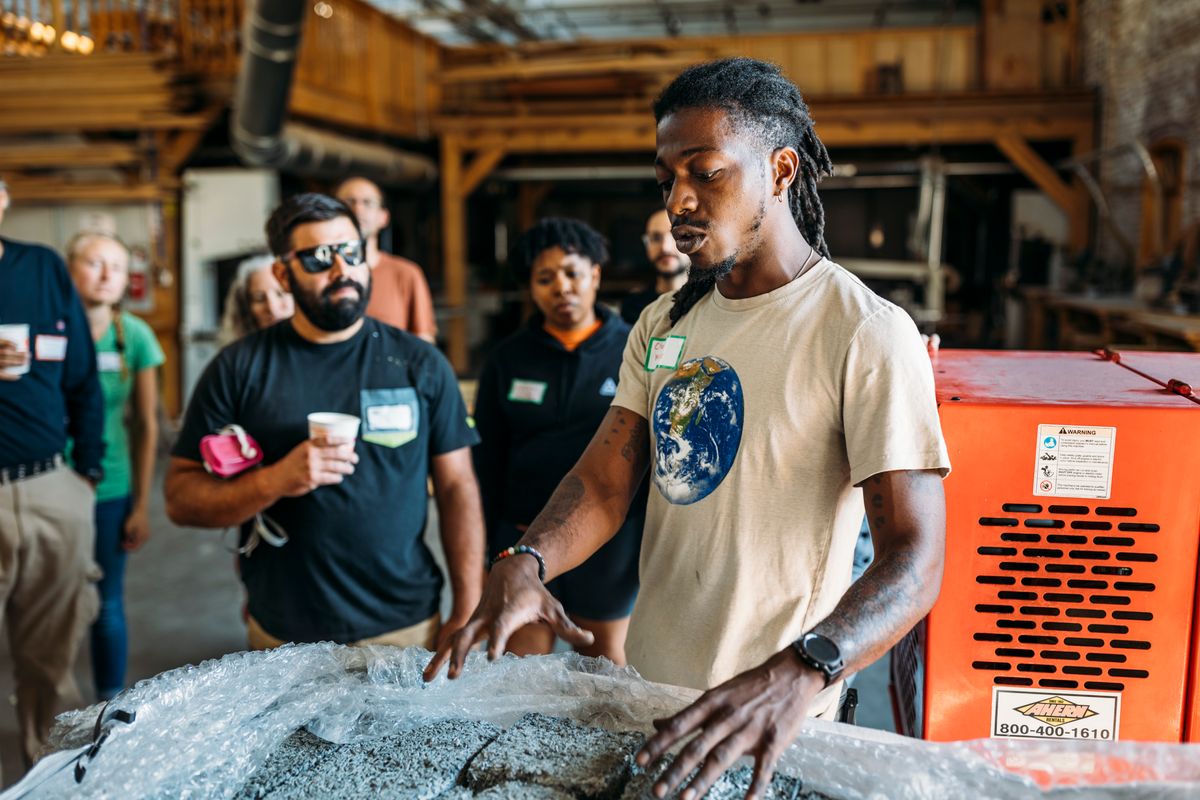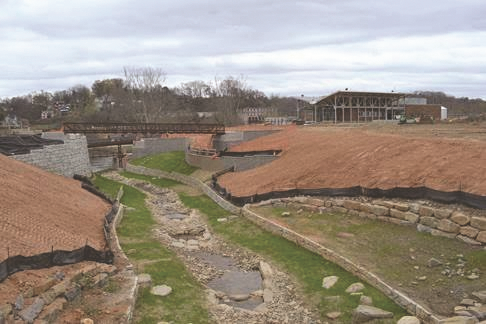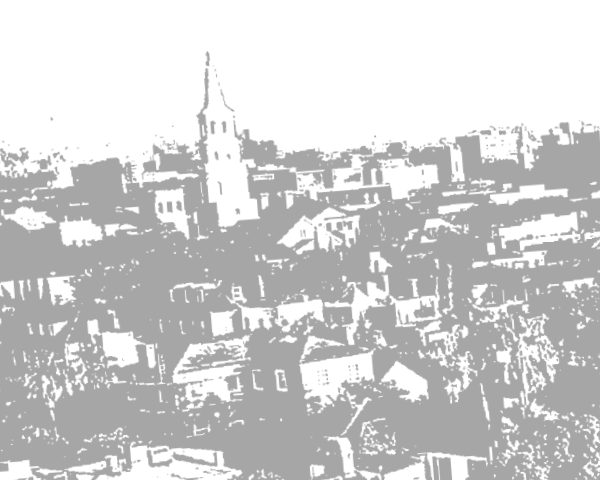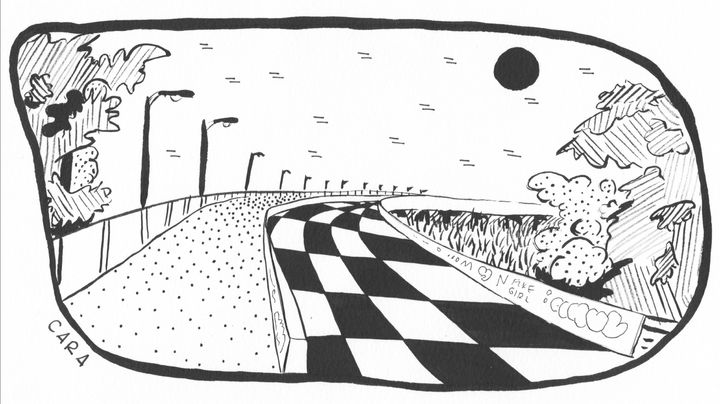Charleston 2030: A Root Down Lowcountry
Alternative building and infrastructure are part of our eco-futurist vision for Charleston. Root Down Designs is leading the way.

by Belvin Olasov
If there’s one word to define the modern era of the Charleston area, it’s development. Apartments, hotels, condominiums, suburbs – we’ve seen a tremendous amount of buildings fill the Lowcountry. And the bones of these buildings – concrete cement, steel, styrofoam, spray foam – drive the climate crisis. Every new development that goes up without recognizing this fact pushes us further away from a livable future.
There’s another way. Instead of embodied carbon, our buildings can be carbon-negative, made of materials that sequester CO2. Architect April Magill, founder of Root Down Designs, has been tuned in to this reality for a long time, and has been working with a collective to change the way we build and, most importantly, what we build with.
“It really is quite simple… plant-based materials are carbon sequesterers. Materials that are derived from plastics and petroleum are not,” Magill said.
If you’ve gone looking to build with alternative building materials in the Lowcountry, chances are you’ve worked with April and Root Down Designs. Her experience with creating these buildings here has given her a deep education in the systemic barriers, from codes to subsidies to builder opposition. In order to transcend these barriers, she’s aimed her sights on cultivating a local circular economy. With the Black Belt Justice Center helping connect Black farmers with industrial hemp cultivation and the Charleston Fab Lab supplying cutting edge building technologies, the goal of disrupting a predatory system of unhealthy development and replacing it with a localized circular economy is becoming closer and closer to reality.
The vision: accessible, equitable, and deeply green housing across the Lowcountry.
MATERIALS
Hempcrete, or hemp-lime, has been used for building for about three decades in Europe and Canada. In America, it’s a new frontier – simply because it wasn’t legal to grow until recently. Production bottlenecks remain, thanks to factors like SC dispensing a limited number of permits per year, but the field of hemp building is rapidly growing and attracting interest from architects, builders, and farmers seeking the cutting edge.
“I see hemp as being literally the future of the material world as we know it. Hemp, flax, sugar cane, and pine, and soy. If you had those five plants, you could make literally anything,” said Nicholas Godfrey, founder of Charleston Fab Lab, key Root Down Designs collaborator.
Hemp is antimicrobial due to the alkaline nature of the lime that it’s mixed with, and hemp fiber has the ability to hold on to moisture for prolonged periods without succumbing to rot or mold. All this makes hempcrete especially well-suited to the Lowcountry, where mold is a major issue, especially among low-income and public housing. It works in concert with wood frames as an insulator and infill, keeping temperatures under control in the building. And, crucially, hempcrete is carbon neutral, meaning localized production can take a giant bite out of buildings’ carbon footprint.
“You could have a building that’s completely insulated with styrofoam and concrete and steel. It’s LEED Platinum and it’s energy efficient and it’s all those great buzzwords, but the carbon output of that building is so far off the charts that, who cares how much energy you’re saving now by running it, right?” she said. “The carbon is so far off the charts that we’re never going to reach any carbon neutral or negative goals if we keep building that way.”
Other materials that Magill has built with include adobe, straw bale, and rammed earth. Through her research, she’s found that SC has rammed earth buildings still standing from 150 years ago – the methods they were built with coming from African cultures that came through the slave trade. These traditional materials have an exponentially smaller carbon footprint, and have been employed around the world for thousands of years.
If you’re wondering why we don’t see more of these types of buildings, one reason is our building codes. South Carolina has yet to adopt a suite of codes called the International Residential Code, which includes tiny house code, straw bale code, adobe code, rammed earth code, and hempcrete code. Without this, each new development requires attention, architectural review, applications, and more that gums up the process. So we continue to build cheaply and destructively.
“All of the cheaper materials, which are going to be your vinyls and your PVCs and your plastics – and that’s all inexpensive because it’s heavily subsidized by the government. And those products, not only are they environmentally destructive and have no recyclability, have no reuse potential… there’s chemicals, there’s the harmful VOCs, there’s carcinogens,” Magill said. “I feel like a lot of these things, these products and materials, are going to be just like asbestos. You know, that was such a common building product and now we know how harmful it is, it’s caused lung damage and cancers. I believe the same thing is going to come out about vinyl flooring and things like that.”
–
Magill didn’t start her architectural career as a green architect. When she came to Charleston after college, she felt like the environment she was working in wasn’t sustainable, but it wasn’t until a backpacking trip and exposure to rammed earth buildings that she began to dig into the world of traditional and green building.
“I was like, ‘Oh my God, I didn’t even know this whole world exists.’ Six years of college, eight years of working, never heard of cob or straw bale or rammed earth or clay plasters.”
From there, she was hooked. She quit her job to join a three week green building workshop in Asheville, synced up with the subculture of builders, artists, and craftspeople there, and began forging a path towards being able to make this happen in the Lowcountry. It was during a trip to a remote Nicaraguan village working with women on rammed earth building that she realized:
“There is power in people. We can build our own structure. We can actually build a house with the dirt we’re standing on. We’re not powerless, don’t have to be slaves to the system, the conventional supply chain that we’re told we have to use, and the codes that are all set up telling us we have to do it this way, because that’s all driven by lobbyists and big money brokers.”
To navigate the power structures and economic pressures that repress green building practices, Magill would have to find collaborators to help disrupt and build independent systems, like Nicholas Godfrey and the Charleston Fab Lab.
TECHNOLOGY
Godfrey and Magill were both interested in working with hemp, and when it finally became available, they quickly realized they were a logical match – she had her background in design, and the Fab Lab had the ability to produce those designs. The Fab Lab’s output runs a wide gamut, from custom-ordered furniture pieces to Krispy Kreme signs, but through fabrication technology, they knew they could tackle the world of building construction.
“We quickly realized that the way we build buildings is stupid inefficient, highly litigious, and just really low quality. And it does not benefit anyone except the person who buys and sells the building and that’s the developer, right?” Godfrey said. “So we desire to industrialize home building in essence in order to bring the quality up and the cost down, and also to start providing influence to the building industry by creating more sustainable ways of doing things. We would like to source products that don’t have to come all the way from China.”
They built out a consortium of the needed professionals – architect, engineer, contractor, digital manufacturer – and collaborated on a fusion of ecological, traditionally influenced architecture and materials with cutting-edge prefabrication technology.
While the average house takes 10 months to build, the Wren 2.0 takes 3 months. Shortening and streamlining the building process saves on expense, and the factory-built nature of each component raises the reliability and quality. While organic materials are more expensive to work with, the prefab approach offsets that traditional barrier to green building.
The hope is that the prefab model can be an important tool in combating the affordable housing crisis in the Lowcountry. Godfrey and Magill are pushing a local policy change: for designs that have already passed through permitting once, we can grant pre-approved one day permit status for subsequent designs on conforming lots. This would be following what’s already done in California, Washington, Vancouver, and other areas, and get buildings on the ground faster amid a deficit.
They’ve already turned their eye towards home fabrication as a disaster relief tool – through work with FEMA, they’ve seen the complications and difficulties of recovery after a major storm event and think their technology can help. They’ve developed data streams, complex arrays of data that commingle, that could track disaster relief progress, existing vulnerabilities, and more.
This data stream technology also opens up unprecedented amounts of information for consumers and responsiveness to new advancements.
“Let’s say an engineer comes up with a component or something that is hemp-based or more cost-efficient. What we aim to do is make that available in real time in this immersive, collaborative design environment,” said Jordan Jackson, project manager at CHS Fab Lab.
“So somebody can actually have the choice of selecting the thing that wasn’t available yesterday but now you have this sustainable item available today. So we’re sort of shortcutting that whole time of going from ideas to something you as a consumer could actually get,” Godfrey said.
–
Magill’s vision doesn’t just lie in what we build with and how it’s built, but also who we’re building for.
“Charleston is just becoming this monolith of wealthy white transplants – an economic class is leaving. Once you eliminate the diversity of class and economy, you’ve killed your city,” she said.
Magill sits on the board of the Community First Land Trust, which puts land in trust for 100 years. Residents can buy and sell buildings, but not the property. Entry is income level-based and prioritizes residents of the communities the Land Trust operates in. This ensures folks can build equity and escape the rent cycle, while also ensuring the land remains with the community and away from rapacious developers.
In a version of the Lowcountry where we prioritized livability and attainability over profits, municipalities and counties would give more support to projects like the Land Trust. Preservation laws would make sure that low-income folks aren’t trapped with decaying housing and allow conversion into affordable housing.
We would build new developments to be mixed-use, allowing where we work and play to be among where we live; mixed-economy, controlling pricing so blue collar folks aren’t sent out to sprawling corners of the Lowcountry; mixed-age, so young folks can support old folks and community can be fostered.
We would build row houses.
“We allow single family housing and then we allow these massive apartments, but where’s the inbetween?” Magill said.
We would zone for accessory dwelling units, tiny houses abutting bigger properties, and quadriplexes for midscale multi-family housing instead of the high carbon footprint of single family homes.
“You’re either going to have density or you’re going to have sprawl,” Magill said.
The vision, in short, is to reject the sicknesses we build into the modern world – toxic materials, cheap production, the isolating and gentrifying forces of unchecked development – in favor of building sustainably, in every sense of the word.


